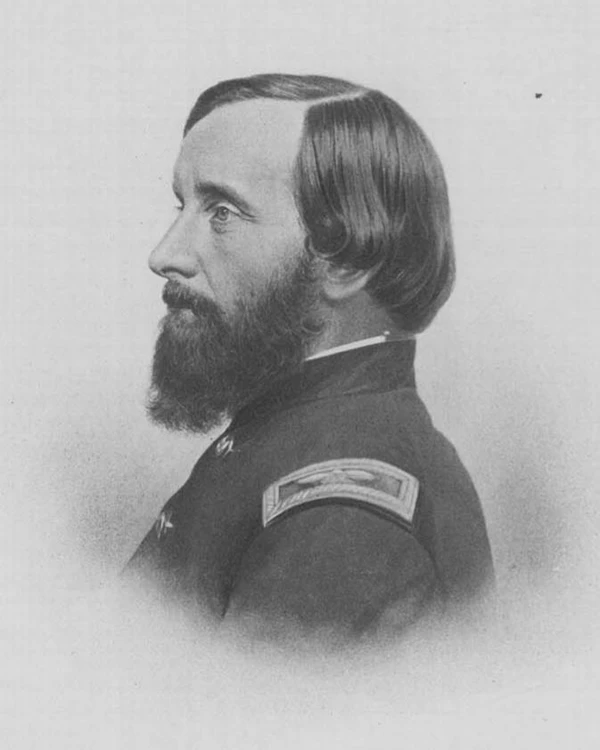Last updated: January 12, 2026
Person
Thomas Wentworth Higginson

Massachusetts Historical Society
Born in Cambridge, Massachusetts in 1823, Thomas Wentworth Higginson, became best known as a radical abolitionist and advocate for women's suffrage, as well as a Unitarian minister, poet, author, and Civil War officer.
Higginson graduated from Harvard in 1841, working briefly as a schoolteacher1 and later as a tutor before enrolling in Harvard Divinity School to become a minister. During this time, he found himself drawn to the causes of abolition and women’s suffrage. Higginson attended abolitionist meetings at Faneuil Hall and wrote abolitionist poems for The Liberator newspaper.2 A radical abolitionist, Higginson believed that the Union should not be preserved if it meant maintaining slavery,3 a position he held until the outbreak of the Civil War.4 This activism took Higginson away from Harvard for over a year, before he returned in 1847 to finish his studies and begin his career as a Unitarian minister.
Higginson started preaching in nearby Newburyport. Despite the support of his congregation, the church's board opposed his radical abolitionism, which led to his resignation only two years later.5 He continued his work on abolition, temperance, and education in Newburyport for two more years.6
In 1851, Higginson joined the Boston Vigilance Committee in response to the Fugitive Slave Law, which he described as a "cruel and unrighteous bill."7 After the arrest of freedom seeker Thomas Sims in Boston that same year, Higginson gave an impassioned speech at Tremont Temple arguing in favor of storming the courthouse to save the imprisoned man, though an attack did not materialize.8
Despite the lack of direct action for Thomas Sims, the arrest of freedom seeker Anthony Burns in 1854 saw Higginson leading a rescue attempt at the courthouse. A small group, including Higginson and abolitionist Lewis Hayden, waited at the courthouse while a mass meeting occurred at Faneuil Hall. They hoped to use the large crowd to storm and overwhelm the courthouse. Confusion and miscommunication prevented a coordinated attack, but Higginson and those gathered with him proceeded to break down the door to the courthouse. Federal agents inside beat back the crowd with clubs, and Higginson suffered a cut to the face.9 The attack did not succeed and the court ordered Burns back to slavery, despite a protest of nearly fifty thousand people in Boston. Federal agents arrested Higginson two weeks later for his role in the attack, but soon dropped the charges.10
Higginson continued supporting direct action against slavery by assisting in the protection of freedom seekers in Boston and financially supporting John Brown in his mission to instigate an armed slave revolt in Harpers Ferry, Virginia. The small group of influential White abolitionists backing Brown’s mission became known collectively as the Secret Six. Many of those who had supported Brown fled the country upon his arrest, fearing possible retribution.11 Higginson felt it necessary to remain "to at least give [Brown] their moral support on the witness stand." 12
In addition to his radical abolitionism, Higginson also advocated for women’s suffrage. In 1853, Higginson spoke at the Women's Suffrage Convention in New York City. He developed a strong friendship with suffragist Lucy Stone.13 He later officiated Stone's marriage to Henry Blackwell where he read and signed her public letter protesting the lack of property rights for married women.14
During the American Civil War, Higginson commanded the 1st South Carolina Volunteers, a regiment comprised entirely of Black soldiers freed from slavery. This unit was based near Beaufort, South Carolina at a site called Camp Saxton, and these were among the first Black men to enlist in the United States Army. While the Emancipation Proclamation allowed for Black soldiers to serve, the Army still required White officers to command them. Higginson addressed this in his Civil War memoir, stating:
We, their officers, did not go there to teach lessons, but to receive them. There were more than a hundred men in the ranks who had voluntarily met more dangers in their escape from slavery than any of my young captains had incurred in all their lives.15
After the War, Higginson continued to advocate for women's suffrage, temperance, and later labor rights as a writer and preacher until his death in 1911.
Footnotes
- Mary Thacher Higginson, Thomas Wentworth Higginson: The Story of His Life (United Kingdom: Houghton Mifflin, 1914), 41.
- Higginson, Thomas Wentworth Higginson, 73.
- Higginson, Thomas Wentworth Higginson, 76.
- “Circular,” The Liberator, August 21, 1857, 4.
- Stephen Kantrowitz, More Than Freedom: Fighting for Black Citizenship in a White Republic, 1829-1889 (United States: Penguin Publishing Group, 2012), 104-105.
- Higginson, Thomas Wentworth Higginson, 107-108.
- Higginson, Thomas Wentworth Higginson, 111., Although this source claims Higginson as a member of the Boston Vigilance Committee, he does not appear on the published membership list nor Austin Bearse's "Doorman's List" of members. Regardless, he did work closely with committee members on major fugitive slave cases in the city. See "Members of the Committee of Vigilance," broadside printed by John Wilson, 1850, Massachusetts Historical Society, Austin Bearse, Remininscences of Fugitive Slave Law Days in Boston, (Boston: Warren Richardson, 1880), “Records of the Vigilance Committee of Boston” (Ms B.17), Garrison Collection, Boston Public Library (BPL).
- Higginson, Thomas Wentworth Higginson, 112.
- Thomas Wentworth Higginson, Cheerful Yesterdays (United States: Houghton, Mifflin, 1898), 154.
- Higginson, Cheerful Yesterdays, 166.
- Kantrowitz, More Than Freedom, 250-251.
- Higginson, Cheerful Yesterdays, 224.
- Higginson, Cheerful Yesterdays, 135.
- Higginson, Cheerful Yesterdays, 137.
- Thomas Wentworth Higginson, Army Life in a Black Regiment (United Kingdom: Houghton, Mifflin, 1900), 331.
